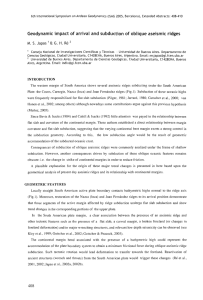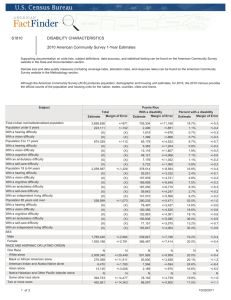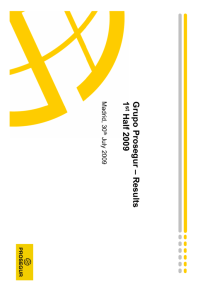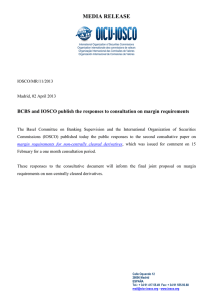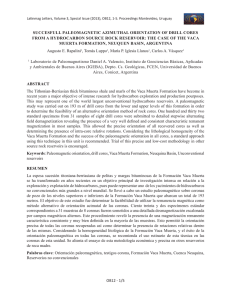NEOGENE TECTONIC BLOCK ROTATIONS AND MARGIN
Anuncio
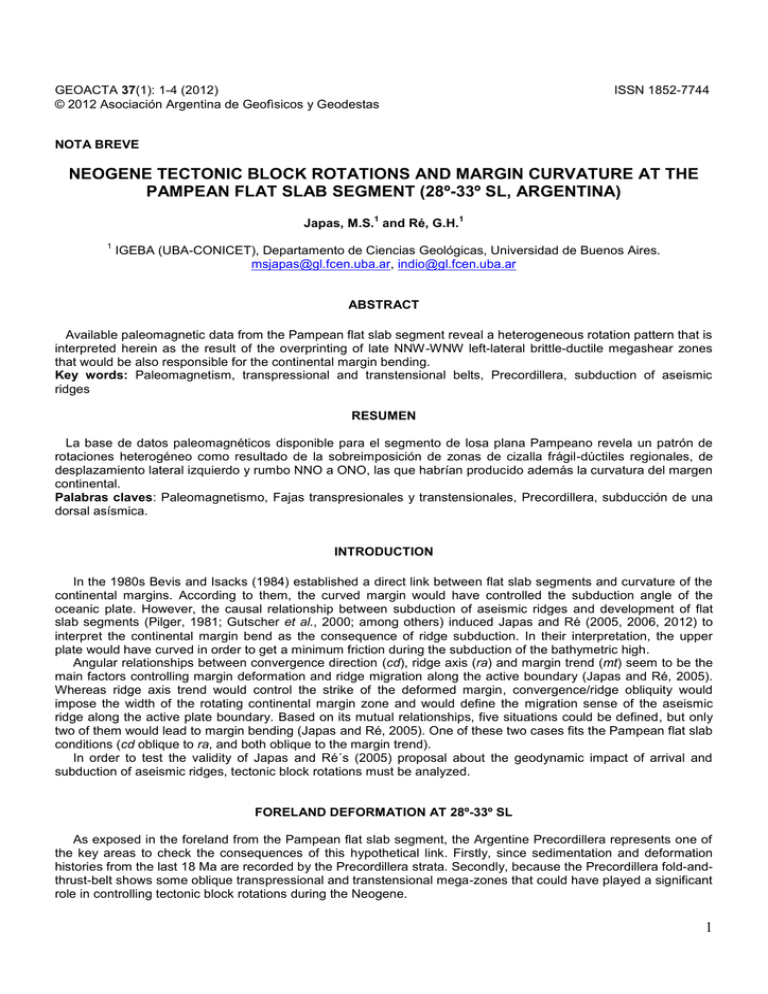
GEOACTA 37(1): 1-4 (2012) © 2012 Asociación Argentina de Geofìsicos y Geodestas ISSN 1852-7744 NOTA BREVE NEOGENE TECTONIC BLOCK ROTATIONS AND MARGIN CURVATURE AT THE PAMPEAN FLAT SLAB SEGMENT (28º-33º SL, ARGENTINA) 1 Japas, M.S. and Ré, G.H. 1 1 IGEBA (UBA-CONICET), Departamento de Ciencias Geológicas, Universidad de Buenos Aires. [email protected], [email protected] ABSTRACT Available paleomagnetic data from the Pampean flat slab segment reveal a heterogeneous rotation pattern that is interpreted herein as the result of the overprinting of late NNW-WNW left-lateral brittle-ductile megashear zones that would be also responsible for the continental margin bending. Key words: Paleomagnetism, transpressional and transtensional belts, Precordillera, subduction of aseismic ridges RESUMEN La base de datos paleomagnéticos disponible para el segmento de losa plana Pampeano revela un patrón de rotaciones heterogéneo como resultado de la sobreimposición de zonas de cizalla frágil-dúctiles regionales, de desplazamiento lateral izquierdo y rumbo NNO a ONO, las que habrían producido además la curvatura del margen continental. Palabras claves: Paleomagnetismo, Fajas transpresionales y transtensionales, Precordillera, subducción de una dorsal asísmica. INTRODUCTION In the 1980s Bevis and Isacks (1984) established a direct link between flat slab segments and curvature of the continental margins. According to them, the curved margin would have controlled the subduction angle of the oceanic plate. However, the causal relationship between subduction of aseismic ridges and development of flat slab segments (Pilger, 1981; Gutscher et al., 2000; among others) induced Japas and Ré (2005, 2006, 2012) to interpret the continental margin bend as the consequence of ridge subduction. In their interpretation, the upper plate would have curved in order to get a minimum friction during the subduction of the bathymetric high. Angular relationships between convergence direction (cd), ridge axis (ra) and margin trend (mt) seem to be the main factors controlling margin deformation and ridge migration along the active boundary (Japas and Ré, 2005). Whereas ridge axis trend would control the strike of the deformed margin, convergence/ridge obliquity would impose the width of the rotating continental margin zone and would define the migration sense of the aseismic ridge along the active plate boundary. Based on its mutual relationships, five situations could be defined, but only two of them would lead to margin bending (Japas and Ré, 2005). One of these two cases fits the Pampean flat slab conditions (cd oblique to ra, and both oblique to the margin trend). In order to test the validity of Japas and Ré´s (2005) proposal about the geodynamic impact of arrival and subduction of aseismic ridges, tectonic block rotations must be analyzed. FORELAND DEFORMATION AT 28º-33º SL As exposed in the foreland from the Pampean flat slab segment, the Argentine Precordillera represents one of the key areas to check the consequences of this hypothetical link. Firstly, since sedimentation and deformation histories from the last 18 Ma are recorded by the Precordillera strata. Secondly, because the Precordillera fold-andthrust-belt shows some oblique transpressional and transtensional mega-zones that could have played a significant role in controlling tectonic block rotations during the Neogene. 1 Oblique transpressional and transtensional belts As a consequence of a long history of terrain amalgamation, the western margin of the South America plate is strongly heterogeneous. This particular condition would induce Neogene deformation to be localized following ancient anisotropies, so previous structures of the upper plate could have accommodated some geometrical changes favoring the margin to curve. Tectonic Fabric Analysis focused on Precordillera revealed two systems of conjugated brittle-ductile megashear zones. The first one comprises left-lateral NNW and right-lateral NNE transpressional sets while the second group involves left-lateral WNW and right-lateral ENE transtensional sets (Japas, 1998, Ré et al., 2001). One of these leftlateral NNW transpressional structures corresponds to the Mendoza Norte zone (Ré et al., 2001) or Barreal-Las Peñas Belt (Cortés et al., 2005; Fig. 1a). Recently, the Rodeo-Talacasto belt was recognized based on the enéchèlon arrangement of a set of thrust-controlled exposures of synorogenic Tertiary rocks aligned with the Loma Negra or Matagusanos brachianticline (Japas et al., 2011). Along this NNW belt, trend of Andean regional thrusts and folds change from NNE to NS/NNW, and NNE-oriented outcrops of Palaeozoic sedimentary rocks are deflected counterclockwise. Confirming the presence of the WNW transtensional zones defined by Ré et al. (2001), Oriolo et al. (2011) recognized the Hualilán belt (Fig. 1a). Tectonic block rotations The first obstacle found during paleomagnetic analysis of foreland tectonic rotations is that there is a wide-range age database. Tertiary units ranging from ~18 Ma to 2,6 Ma display variable tectonic rotations, a time span that severely complicates a direct comparison of data (Fig. 1b). Therefore, tectonic block rotations revealed by paleomagnetic data show a complex pattern. However and still working for a more complete data frame, some considerations could be made: a) When compared with other Andean regions, paleomagnetic results at the 28º-33º SL segment reveal a rather different pattern. Instead of a general homogeneous Tertiary clockwise-rotation pattern, the foreland at the Pampean flat slab domain shows some localized areas registering no significant block rotation (Fig. 1b). b) When assembled by rock age, paleomagnetic data can be grouped into an older population (18-14 Ma, I in Fig. 1b), an intermediate (14-6 Ma, II) and a younger one (< 6 Ma, III). Tectonic block rotation values for the first group (Fig. 1b) reveal predominant higher clockwise rotations (ranging from ~10º to 35º) than younger Tertiary strata which show no evident paleomagnetic rotations. DISCUSSION Paleomagnetic data and tectonic fabric reveal a heterogeneous behaviour of Precordillera during Neogene deformation. The evolution of Neogene basins in Precordillera was depicted by Jordan et al. (1999) who considered three stages: i) simple foreland (20-7.3 Ma), ii) symmetrical intermediate (7.3-6.5 Ma), and iii) late broken-foreland (6.5-0.0 Ma). During the simple foreland stage, synorogenic deposits had to be controlled by the NNE orogenic front in the west. An Az 76º convergence should have imposed transpressional motions to these NNE structures (thrust-dextral), and therefore, clockwise block rotation should be expected. This scenario would have changed when the sinistral NNW transpressional set of structures activated (intermediate and brokenforeland stage), and then localized counterclockwise rotations would have modified the previous clockwise pattern, giving rise to lower values (up to now counterclockwise values have been only recognized in the El Tigre region where Fazzito et al., 2011 interpreted them as a local effect associated with dextral wrenching). Block rotation pattern in the foreland contrasts with that in the forearc. Between 27ºSL and south of 33ºSL, some recognized tectonic rotations in Chile (Arriagada et al., 2009) allow partitioning the forearc region into four segments. Clockwise rotations (~30º to 39º) would represent the north-of-28ºSL and south-of-33ºSL sectors, whereas low (~18º) and very low (~4º) clockwise rotations are revealed for the 28º-30ºSL and 30º-33ºSL segments (Fig. 1c). These paleomagnetic results indicate younger rotations south (post-Late Miocene) than north (postOligocene), a result that agrees with the expected and observed migration of deformation during the Juan Fernández ridge (JFR) subduction. The line that divides the north-of-28º SL paleomagnetic domain (Vallenar Axial Zone, VAZ) extends inland coinciding with the Guandacol WNW transtensional belt defined by Ré et al. (2001), whereas the ~30º SL transition matches with the WNW Hualilán zone (Fig. 1a). At 33ºSL (the present-day position of the JFR), Arriagada et al. (2009) define the axial zone of the Maipo megakink. Considering a regional Paleogene scenario of nearly homogeneous clockwise ~35º rotations (Arriagada et al., 2008), the arrival of the JFR after the Oligocene (28º SL) could have induced the margin to curve. Overprinting counterclockwise tectonic rotations could then have produced a significant reduction in Paleogene clockwise rotation values (Fig. 1c). 2 3 Figure 1: a. Structural fabric of Precordillera showing some transpressional and transtensional belts (Ré et al, 2001). SJ: San Juan city; M: Mendoza city. b. Paleomagnetic data discriminated by age of the considered strata (recalculated from Ré and Rapalini, 1995, and data from Basile, 2004, Fazzito et al., 2011). Grey fields i, ii, iii refer to the foreland basin stages defined by Jordan et al. (1999). I, II, III indicate the different paleomagnetic populations identified herein. c. Sketch showing the paleomagnetic constraints for bending of the continental upper plate margin (paleomagnetic data from Chile: Arriagada et al., 2008). Black arrows indicate present-day rotation values; white arrows (forearc) represent the regional clockwise rotation pattern previous to the arrival of the JFR; grey arrows (foreland) symbolize regional clockwise rotation pattern linked to the early subduction of the JFR and consequent transfer of deformation into the foreland. CONCLUSIONS Tectonic block rotations at the Pampean flat slab segment show a more heterogeneous and complex pattern at the foreland than at the forearc. However, in both cases they would reveal the overprinting of a late stage of counterclockwise rotations over an early clockwise pattern linked to the oblique convergence of the Nazca plate. These counterclockwise rotations would be associated with NNW and WNW structures, whose activity would have produced the bend of the upper plate margin. REFERENCES Arriagada, C., C. Mpodozis, G. Yáñez, R. Charrier, M. Farías y P. Roperch, 2009. Rotaciones tectónicas en Chile central: El oroclino de Vallenar y el “megakink” del Maipo. 12º Cong. Geol. Chileno: 1-4. Basile, Y.A., 2004. Estudio geologico y geofísico del sector sur de las Lomas del Inca, provincia de San Juan. Trabajo Final de Licenciatura, Univ. De Buenos Aires, inédito. Bevis,M. and Isacks,B., (1984). Hypocentral trend surface analysis; probing the geometry of Benioff zones. J. of Geophys. Res. 89 (B7) : 6153-6170. Cortés, J.M., M. Pasini and M. Yamin, 2005. Paleotectonic controls on the distribution of Quaternary deformation in the southern Precordillera, Central Andes (31°30´-33° SL). 6th ISAG : 186-189. Barcelona. Fazzito, S.Y., A.E. Rapalini, J.M. Cortés and C.M. Terrizzano, 2011. Kinematic study in the area of the Quaternary oblique-slip El Tigre Fault , western Precordillera, Argentina, on the basis of paleomagnetism and anisotropy of magnetic susceptibility. Latinmag Letters 1(2), B24, 1-5. Proceedings Tandil, Argentina. Gutscher, M., Maury, R., Eissen, J.-P. and Bourdon, E., 2000. Can slab melting be caused by flat subduction? Geology 28, 535–538. Japas, M.S., 1998. Aporte del análisis de fábrica deformacional al estudio de la faja orogénica andina. Homenaje al Dr. Arturo J.AMOS. Rev. Asoc. Geol. Arg. 53 (1) : 15. Buenos Aires. Japas, M.S. and G.H. Ré, 2005. Geodynamic impact of arrival and subduction of oblique aseismic ridges. 6th ISAG : 408-410. Barcelona Japas, M.S. and G.H. Ré, 2006. Margin curvature related to subduction of oblique aseismic ridges. Backbone of the Americas, Patagonia to Alaska : 35. Mendoza. Japas, M.S. and G.H. Ré, 2012. Margin curvature at 28º-33º SL induced by oblique subduction of the Juan Fernández aseismic ridge: Paleomagnetic constraints. 8th ISAG, unpublished. Antofagasta, Chile. Japas, M.S., G.H. Ré, J.F. Vilas and S. Oriolo, 2011. Oblique megashear zones in the Precordillera (Central Andes, Argentina): The Rodeo-Talacasto transpressional belt. DRT Conference, Oviedo. Jordan, T., F. Schlunegger y N. Cardozo, 1999. Múltiples hipótesis en la evolución de la cuenca neógena de antepaís de Bermejo, Argentina. 14º Cong.Geol.Arg. 1: 193-196. Salta. Oriolo, S., M.S. Japas and E.O. Cristallini, 2011. Transtensional megashear zones in the Central Andes: the Hualilán Belt (Precordillera, Argentina). DRT Conference. Oviedo. Pilger, R.H., 1981. Plate reconstructions, aseismic ridges, and low angle subduction beneath the Andes. Bull. Geol. Soc. Am. 92 : 448–456. Ré, G.H. and A.E. Rapalini, 1995. Non-systematic neogene crustal block rotations in the Andean foothills of Central Argentina. Curved Orogenic Belts, Abstracts : 31-37. Buenos Aires. Ré, G.H., M.S. Japas y S.P. Barredo, 2001. Análisis de fábrica deformacional (AFD): El concepto fractal cualitativo aplicado a la definición de lineamientos cinemáticos neógenos en el Noroeste Argentino. Asoc. Geol. Arg., Serie D: Public. Espec. 5: 75-82. 10º Reunión sobre Microtectónica, Buenos Aires. Recibido: 24-02-2012 Aceptado: 28-05-2012 4
